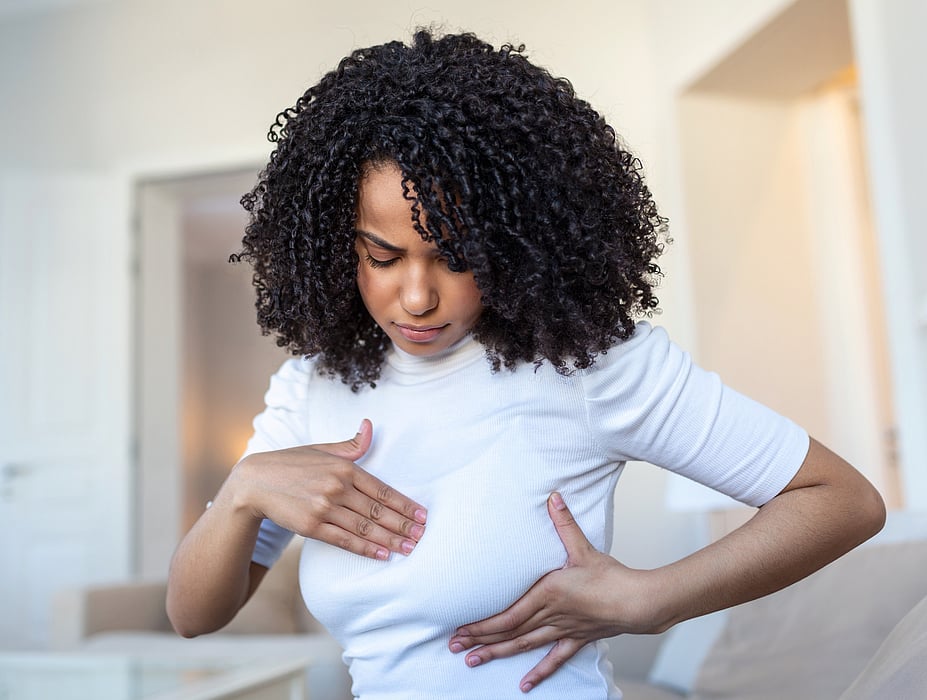Benign Breast Lumps: Types, Causes, Symptoms & Treatments

You've discovered a lump in your breast and you begin to panic, but what if it's benign?
That's often the case, with most lumps found in the breasts turning out to be noncancerous, according to the American Cancer Society (ACS).
Here, experts will guide you through the different types of benign breast lumps, what causes them, how they look and feel and the best ways to treat them.
Benign breast lumps
Fibroadenoma
A review published recently in the Deutsches Ärzteblatt International journal revealed that about 25% of women have fibroadenomas, and they’re the most common type of benign breast tumors.
The ACS explains that fibroadenomas are made up of two types of breast tissue: glandular and connective. They’re usually round and the larger ones may feel like marble. Some also feel firm and rubbery, but they aren’t painful.
“You can draw a smooth line around the edges of a fibroadenoma, which is typically oval-shaped,” Memorial Sloan Kettering Cancer Center radiologist Dr. Sandra Brennan said in a recent article.
Although the exact cause of fibroadenomas aren’t known, StatPearls states that breast tissue sensitivity to the hormone estrogen may lead to their development. The vast majority require no treatment.
Breast cysts
When fluid fills up the breast’s mammary glands, cysts develop. The Cleveland Clinic says most breast cysts are round, smooth, have clear borders and are soft to the touch, although some are firm.
You might notice pain and tenderness around the time of your period if you have a breast cyst. Natural monthly changes in hormone levels are thought to be the reason why they develop. They usually don’t require treatment and will go away on their own.
Breast hyperplasia
The two main types of breast hyperplasia are usual ductal and atypical. They’re caused by an overgrowth of cells lining the lobules and ducts. Both increase your risk of breast cancer, according to the ACS.
It can be difficult to feel breast hyperplasia lumps with a self-breast examination and that’s why they’re typically detected with a mammogram.
Although screenings are important, usual ductal hyperplasia isn’t considered abnormal, and it’s typically left untreated. With atypical hyperplasia, your doctor may recommend the removal of the breast tissue surrounding the lump.
Fibrocystic breast changes
Because of normal monthly hormonal changes, your breasts can look and feel swollen, painful, tender and lumpy right before you menstruate. Both the Cleveland Clinic and ACS say these fibrocystic breast changes are natural and don’t require treatment, since they go away on their own.
Breast papillomas
When the cells of the outer (epithelial) layer of breast duct tissues rapidly reproduce, noncancerous lumps known as papillomas can form within these ducts, according to StatPearls.
The ACS says these tumors are similar to warts, and their main symptom is a bloody discharge of the nipple, especially if they form in the larger ducts. If they grow in the smaller ducts, you’re more likely to have multiple papillomas.
If your doctor determines that the size of the papilloma or your risk for developing more serious breast issues warrants treatment, surgery may be suggested to remove it.
Granular cell tumor
Though rare, lumps may form in the Schwann cells that surround breast nerve cells, according to the ACS.
DermNet New Zealand says that these painless granular cell tumors may be caused by a genetic mutation, and they’re more common in people with dark skin. The tumor itself can be the color of the skin or slightly brown-red, and it’s usually the size of a small nodule. You might also notice either roughness or smoothness of the skin over the tumor.
Granular cell tumors can be surgically removed, and postsurgical monitoring helps track their recurrence.
Fat necrosis
Fat necrosis is another name for scar tissue that forms after breast tissue has been injured. The ACS says it can start as an oil cyst that’s formed from dying fat cells. This sac eventually hardens as the tissue heals.
“We commonly see it after surgery in patients who have had lumpectomies, breast reduction surgery or mastectomies,” Brennan explained.
Though not painful, symptoms include red, bruised or thick skin around the fat necrosis lump. It poses no risk for breast cancer and needs no treatment, although a surgeon can remove it if becomes too big.
Lipoma
Lipomas of the breast are lumps made up of fat cells. They develop in mesenchymal stem cells, according to StatPearls. While scientists are unsure of their exact cause, trauma and genetics may both play a role.
The Mayo Clinic states that breast lipomas tend to grow slowly and feel doughy to the touch, although the ACS notes they’re not typically painful. In most cases, treatment is not necessary, according to StatPearls.
When to see your doctor
If you notice a lump, Brennan said to contact your doctor right away.
“Many lumps turn out to be benign,” she explained. “But the most important thing is to not ignore it. Get it checked out.”
Related Posts
What Do You Know About Your Risk for Hernia?
SATURDAY, Aug. 27, 2022 (HealthDay News) -- Could you be at risk for a hernia?...
Bicycle Safety (Adults)
You never forget how to ride a bike. But if you're like many adults, you might...
